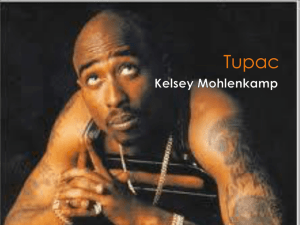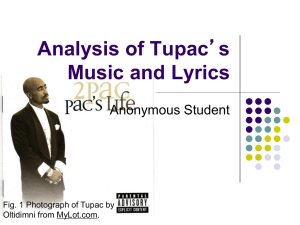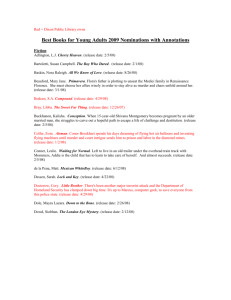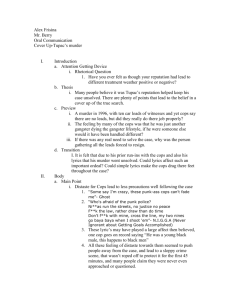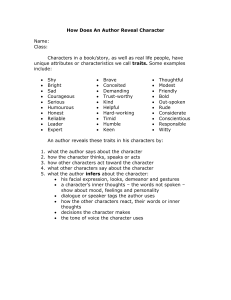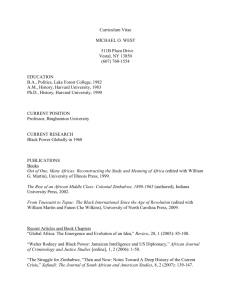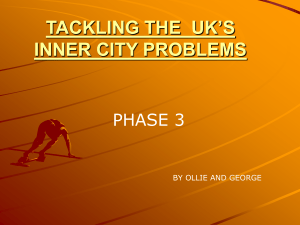1 Hope, Love, and 'A Politics of Conversion'
advertisement
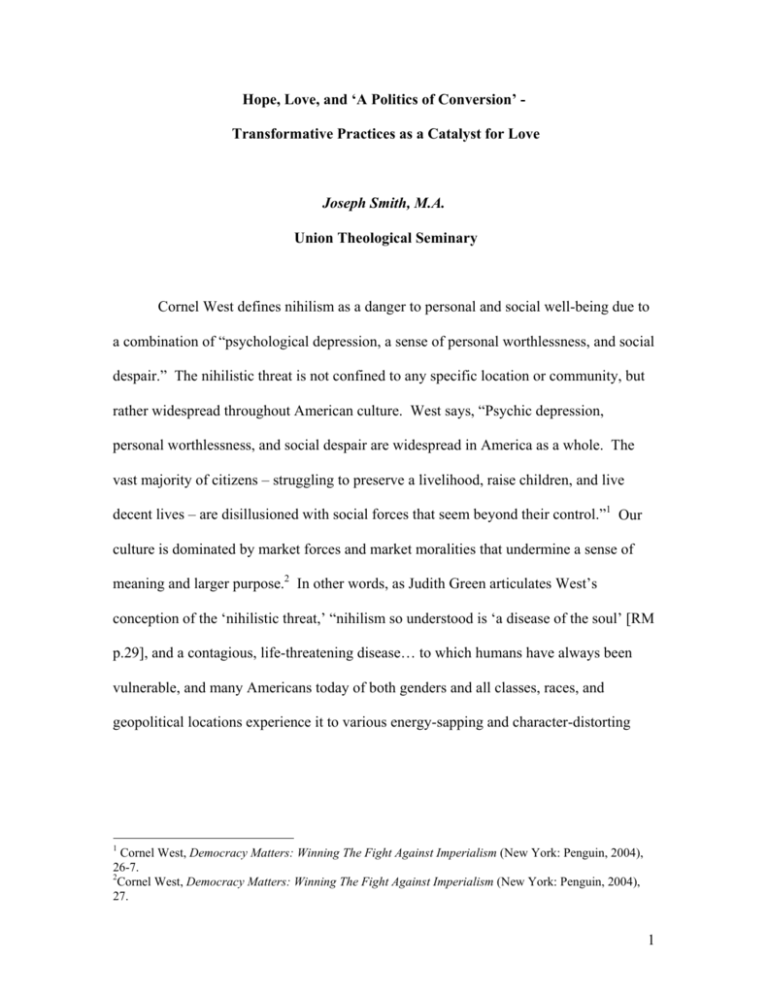
Hope, Love, and ‘A Politics of Conversion’ Transformative Practices as a Catalyst for Love Joseph Smith, M.A. Union Theological Seminary Cornel West defines nihilism as a danger to personal and social well-being due to a combination of “psychological depression, a sense of personal worthlessness, and social despair.” The nihilistic threat is not confined to any specific location or community, but rather widespread throughout American culture. West says, “Psychic depression, personal worthlessness, and social despair are widespread in America as a whole. The vast majority of citizens – struggling to preserve a livelihood, raise children, and live decent lives – are disillusioned with social forces that seem beyond their control.”1 Our culture is dominated by market forces and market moralities that undermine a sense of meaning and larger purpose.2 In other words, as Judith Green articulates West’s conception of the ‘nihilistic threat,’ “nihilism so understood is ‘a disease of the soul’ [RM p.29], and a contagious, life-threatening disease… to which humans have always been vulnerable, and many Americans today of both genders and all classes, races, and geopolitical locations experience it to various energy-sapping and character-distorting 1 Cornel West, Democracy Matters: Winning The Fight Against Imperialism (New York: Penguin, 2004), 26-7. 2 Cornel West, Democracy Matters: Winning The Fight Against Imperialism (New York: Penguin, 2004), 27. 1 degrees.”3 Yet, West notes that the impact of nihilism on the disadvantaged is even more devastating. West’s examination of the increasing nihilism in black America highlights “the lived experiences of coping with a life of horrifying meaninglessness, hopelessness and (most importantly) lovelessness,” that leads to “a numbing detachment from others and a self-destructive disposition toward the world.”4 I would add that the phenomenological existence of nihilism is internalized by individuals, and those who have thin cultural armor and resources, and are devoid of life-affirming communities are most vulnerable. The internalization of a life without hope and absence of meaning produces and nurtures individuals who violently destroy themselves and others. My aim in this paper is to explore nihilism through the art of Tupac Shakur and briefly present West’s ‘politics of conversion’ and an individuation process as a possible guide to move through nihilism. I will: (1) present eight specific themes that Tupac chose to highlight in his art, (2) describe West’s ‘politics of conversion,’ and (3) offer an individuation process as a catalyst for love. Moving out of his particular lived experiences, Tupac highlighted eight themes that spoke directly to his personal and social conflicts.5 Tupac’s art not only sought to express and give voice to himself and his community, but also contained something more dark and cynical. Wedded to justified social rage, this inner voice often overwhelmed him, resulting in Pac’s intentional decision to perpetuate violence onto others through his 3 Judith Green, Deep Democracy: Community, Diversity and Transformation (New York: Rowan & Littlefield Pub., 1999), 160. 4 Cornel West, Race Matters (New York: Vintage Books, 1994), 22-23. 5 I want to make clear that these different themes are not categories as ends in themselves, but are rather extremely interconnected and organic to each other. 2 art and in his everyday interactions with people, especially women.6 The eight themes that Tupac explored in his work are as follows: (1) Pain, (2) Guilt/Remorse, (3) Community, (4) Meaninglessness, (5) Lovelessness, (6) Hopelessness, (7) Death, and (8) Violence. Pain operates at the deepest level of one’s being, as a present lived and historical/intergenerational experiences of everyday traumas, stemming from unnecessary forms of personal and social misery, namely racism, poverty, and gender hierarchies. One of the most devastating results of the pain that Pac speaks about is the creation of a cold-hearted person with a mean-spirited disposition which leads to a numbing detachment from self and others.7 This type of pain gets played out in the world as a selfdestructive outlook, of which everyday violence to one’s self and others is the end consequence. Guilt/Remorse results from the necessarily simplistic conflicts that arise in the interplay of being a victim and perpetrator of crimes against humanity, known as ‘dirt’ (basically the meaning of this word is doing whatever it takes to get what one needs to survive: selling drugs, hustling people, robbery, etc.). This struggle creates in the individual a more profound sense of worthlessness and pain. In a sense, guilt/remorse destroys the self. As Pac states, “can’t sleep, cause all the dirt make my heart hurt” (OMB), (emphasis mine). Pac emphasizes the guilt linked breakdown and broken connects of and within the community, namely that of family and neighborhood bonds. 6 “No one can talk about pain like Tupac. ‘No one knows it like me,’ he says. ‘It separates me from other rappers. All that pain I’m talking about in my rap, you can see it.’ All too clearly sometimes. Apparently, it is not just something he works out in his music or in his acting- it’s something he carries into his relationships with women, with his peers, with authority figures.” Kevin Powell. http://www.tupacfans.com/thugslife.php. 7 Cornel West, Race Matters (New York: Vintage Books, 1994), 23. 3 Instead of a close-knit community, people have become cold strangers with no or little link to supportive and sustained life-affirming networks: “Brothers cry from broken lives, mama come inside/ cause our block is filled with danger/ used to be a close knit community, but now we’re all cold strangers” (OMB). Meaninglessness is a concept that notes a collapse of meaning and the growth of a sense of worthlessness. This theme is not just a reaction to what other people think, especially the dominant society, but also accentuates one’s active participation in the degradation and destruction of self and others. In other words, meaninglessness is a devaluation of self and others, which moves individuals towards a disposition of giving up on life or an inclination towards a ‘death wish,’ which results in the negation of any sense of life-affirming meaning that other wise may lend itself to struggle and resistance. The artist Biggie Smalls, a one-time best friend of Tupac, best exemplifies the depth of this. In a song named “Suicidal Thoughts,” in which he kills himself at the end of the song, Biggie says, “when I die fuck it I wanna go to hell/ cause I’m a piece of shit it ain’t hard to fuckin’ tell/, …, All my life I been considered as the worst/ Lyin' to my mother, even stealin' out her purse/ Crime after crime, from drugs to extortion/ I know my mother wished she got a fuckin' abortion.” Lovelessness implies that there is no love and/or absence of love of self and others. This is not what Pac has in mind, for he boasts on a number of different songs of his love and loyalty to his mother and those he identified with. His understanding of lovelessness deals more with the lack of love that inhibits the self from feeling and having faith in one’s own uniqueness, individuality, and preciousness - the absence of a 4 type of love that builds up the self in positive ways, giving one a sense that life does matter: My life in exchange for yours, born hated as a thug House full of babies cryin from a lack of gettin love Ain't nobody tell me shit, 'til I got a sack of drugs Had the block sewn up, cause I learned to pack a gun, do you feel me? World do ya hear me? Catch a risin star Fuck the love, niggaz fear me Got these niggaz runnin all wild from my double-I When we ride motherfuckers is sho' to die8 Starting from empirical experience as the point of departure for the possibility of a possibility of hope that one’s future days of living will be better, it seemed to Tupac that such a radical change was not possible, leading to a profound sense of hopelessness and despair. The theme of hopelessness functions on two levels: social and personal. Social deals with the limits and limited expectations placed on individuals by the larger dominant society (including the social, economic, political, and cultural hierarchal structures of misery and oppression) and the immediate community that Tupac found himself in (especially the keep it ‘real’ mentality). The personal speaks to the internalized self-destructive, self-worthlessness, and self-lovelessness dispositions gathered from empirical reality. The personal is a struggle and dialogue with the inner daemons in that there is a guttural cry to change: “This ain’t the life for me/ I wanna change/ but ain’t no future right for me/ I’m stuck in tha game” (SMT). There are two questions at the heart of Tupac’s guttural cry: how can God or anyone else love me after all I’ve done, and how do I listen to the guiding life-affirming voice. This cry searches out for a mystical experience as well as an embodied partnership that helps to encourage and support the yearning for change. 8 Shakur, Tupac. “Made Niggaz,” Gang Related 5 Tupac stresses two types of death: physical and a ‘living death.’ The physical represents the violent homicide and suicide of individuals. A ‘living death’ is the notion of not wanting to live the lifestyle that one does, but seeing no way out except in embracing an early death. In other words, it is not the case that individuals want to die, actually they want to live. But if a certain lifestyle cannot be transcended or existentially one cannot choose her or his own mode of being in the world, then death is wished for. In this sense, one gives up on life, becoming detached and numb on many different levels: emotional, spiritual, psychological, social, etc. This type of death often leads to a life of self-medication and, a slow and lonely physical death. Violence stems from the ontological injuries and emotional scars that one has sustained from the world, which in turn are internalized and returned to the world through pain and rage, the projected path through the self and through others. This selfdestructive temperament rears its ugly head in extreme violence in everyday life, through what is know as gangster mentalities. Outward acts of harm done to the self and others are the most obvious signs of the destructive power of gangster mentalities. But individuals who participate in this mentality are destroyed as well. Acting out of a group, the individual gets lost, and the self becomes fragmented and restricted by the group. Cornel West notes that the gangster mentality is not limited to specific communities, but rather, our whole post-modern society is saturated by a “market culture dominated by gangster mentalities and self-destructive wantonness,” of which the impact on the disadvantaged is devastating.9 The themes that Tupac chose to highlight are not only a matter of philosophical inquiry and artistic expression, but a more profoundly serious matter exists, namely a 9 Cornel West, Race Matters (New York: Vintage Books, 1994), 10. 6 struggle between life and death. Tupac himself was caught up in these themes and survival by any means necessary or what Pac calls ‘thug life,’ the mode of being or way of life as a method to deal with them. Sometime in 1994/5, Pac began to experiment with the idea of the possibility for a possibility of hope that would allow him to move through these themes in a radically different way. Unfortunately, Tupac was gunned down in the streets. Part of the tragedy of his death is that he did not have enough lifetime or resources to work through what these themes might mean in terms of a new selfunderstanding and a new mode of living, instead he dies loyal to the game. What is to be done? Cornel West’s answer is, “A politics of conversion,” that highlights the interplay, or dialectical and dialogical exchange between civil institutions, grassroots organizations, or created spaces that promote life-affirmation of the ‘me’ and that re-energize a shattered ‘I.” West calls for a new collective black leadership that not only puts forth new models of hope and meaning, but models that can help people to believe and embody the possibility of a possibility of hope for a personal conversion and social transformation. This new leadership or what West calls in an expanded form in Keeping Faith, ‘the new cultural politics of difference,’ must adequately put forth intellectualized understandings of “the precise circumstances of our present moment,”10 that calls for an analyses of what justice requires and “how racism, sexism or class subordination operate,”11 in order to offer an effective transformative model. The new cultural politics of difference must be a ‘critical organic catalyst,’ who stay linked to the best models, viewpoints and methods the mainstream has to offer, while aligned with the wretched of the earth and committed to creating a culture of unrelenting critique of and 10 11 Cornel West, Keeping Faith (New York: Routledge, 1993), 4. Cornel West, Race Matters (New York: Vintage Books, 1994), 29. 7 resistance to organized life-denying forces. While analysis of what justice requires and scrutiny of structures of domination is indispensable, West asserts that this disease of the soul needs something more if it is to be overcome. The turning of one’s soul is not done by highly intellectualized argumentation or analyses, but with love and care. West realizes that it is the individual, whom must face nihilism and turn her or his soul, but this turning must be encouraged and given energy by an embodied caring and loving partnership and/or community. As West compassionately states, “a turning of one’s soul … is done through one’s own affirmation of one’s self worth – an affirmation fueled by the concern of others.”12 This love ethic proposes to empower individuals through caring relationships that help create new hopes and shared meaning. The love ethic, which focuses upon the uniqueness and preciousness of individuals, functions to increase self-valuation. Thus, any effective transformative model espoused by this new politics must have a love ethic at its center. Also, this love ethic must be grounded in political resistance, which reaches back in history to subversive or counter-hegemonic cultures. The goal is to reconstruct shared memory in the best of subversive traditions. This memory takes a critical approach that scrutinizes the norms, solutions, and self-images of past responses to cultural ways of life fostering “hopeful visions of the good life.”13 West’s hopes of ‘a politics of conversion’ are twofold: (1) that this new leadership can generate enough love and care so that shattered individuals internalize this love ethic themselves and thereby empower herself or himself to feel her or his own preciousness, and (2) that a new meaning of political struggle can be created out of a tradition “rooted in subversive memory, .., guided by a 12 Cornel West, Race Matters ((New York: Vintage Books 1994), 29. Judith Green, Deep Democracy: Community, Diversity and Transformation (New York: Rowan & Littlefield Pub., 1999), 160. 13 8 universal love ethic.”14 But, if we take West’s recognition of nihilism leading to ‘a numbing detachment from others and a self-destructive disposition toward the world, and the two questions at the heart of Tupac’s guttural cry: how can God or anyone else love me after all I’ve done, and how do I listen to the guiding life-affirming voice, How do such individuals open themselves up to a love ethic? How does one begin to create pockets of inner joy, strength, and love in one’s self? How does one move into a position of faith in one’s own preciousness? How does one embody a faith that life matters? How does one learn to love and be loved in a sustained life-affirming relationship? What does one do with a profound sense of guilt/remorse (referring to the destruction of self and others)? How does one dialogue and dialectally engage the inner daemons? How does one grow? How does one forgive one’s self? How does one heal? Although I will not attempt to answer all these questions, I will briefly offer an individuation process that hopefully provides important tools and insights with which attempts to use transformative practices as a catalyst for love. I believe the most helpful tools for such an attempt is a critical consciousness, deliberation process and transformative communities. I will look to John Dewey and Judith Green to provide us with some of the tools that we will need. Dewey’s critical consciousness inquires into the particular circumstances of the environment, seeking to put forth a detailed and specific understanding and analysis of the personal and social conflicts that are in need of amelioration. Critical consciousness seeks to understand concrete and specific social phenomena that an individual or community lives within, undergoes, responds to, and may be able to transform. This inquiry entails that we understand and analyze what ideas are employed and embodied, 14 Cornel West, Race Matters ((New York: Vintage Books 1994), 30. 9 how the community, society, and intuitions are arranged, and the consequences of these ideas, norms, and arrangements. Also, critical consciousness attempts to sidestep the trap of rigid, dogmatic, and finalized forms of inquiry. Dewey asserts that “specific problems vary with the changes in human life that are always going on and that at times constitute a crisis.”15 For example, inquiry into the idea of racism must take into account how it functions specifically for an individual or group in the particular present historical conditions. Critical consciousness comes to terms with the specificity of each unique guttural cry, especially at the level of the historical, generational lived experience of ontological wounds and emotional scars. This aspect focuses on the question of how a particular set of circumstances are for me and attempts to categorize ‘pockets’16 of inner spaces, or an individual’s particular kinds of inner struggles with what Tupac has named ‘inner daemons.’ The idea of an inner struggle is not limited to the direct connection and enabling of anxiety, near hopelessness, and felt lovelessness by specific happenings in a particular environment, but also includes an individual’s participation and perpetuation in reproducing an overwhelming visceral pain. In this sense, critical consciousness not only takes account of an undergoing of suffering and pain, but also an individual’s active participation in it. In short, I suggest that critical consciousness must take account of and put forth an understanding of the inner daemons that stem from and are supported by both the environment and the responsive-creative self. Critical consciousness must inquire into what specific kinds of social beings are created in specific circumstances as well as 15 John Dewey. Reconstruction in Philosophy. New York: Henry Holt. In John Dewey: The Middle Works, 1899-1924, Volume 12, ed. by Jo Ann Boydston. (Carbondale: Southern Illinois University Press, 1980), vi. 16 I use this word to indicate that inner daemons are put one out of a multiplicity of sensations categorized in our inner spaces. 10 the internalization process of particular individuals in light of what inner categories are produced, especially those at the level of inner daemons that produce anxiety, hurt, selfdestruction, near hopelessness, and lovelessness, or what I shall call ‘lifestyles of misery.’ At this juncture we must ask, once an individual becomes critically conscious of herself or himself as a socially created being, including social and existential concerns, how can change happen at the deeper level of personal and social signs and symbols, especially those that produce and perpetuate social misery and overwhelming inner daemons? Part of attempting to answer this question brings us to Dewey’s deliberation process. Dewey refers to the deliberation process as using the inner life as a site for a ‘dramatic rehearsal.’17 ‘Dramatic rehearsal’ uses memory and constructive imagination to critically think through competing future possibilities for a reconstruction of habits of action and of the heart that may resolve a problematic situation. Dramatic rehearsal uses constructive imagination as a site for experimentally rehearsing possible new habits; it begins in memory, yet attempts to creatively move beyond our most subjective and private feelings.18 Constructive imagination takes seriously those memories, including habits of action and heart, that produce anxiety, near hopelessness, and felt lovelessness which results in an almost morbidity of future possibilities. It highlights the fact that there exist in the inner life overwhelming impulses and habits that dominate a course of action and heart, and that cloud the possibility for alternative ways of reconstructing habits of action and of the heart within the deliberation process toward action, especially in constructive imagination. These overwhelming forces not only govern and obscure the 17 John Dewey. Human Nature and Conduct, ed. by Jo Ann Boydston, in John Dewey: The Middle Works, 1899-1924. (Carbondale: Southern Illinois University Press, 1980), 132. 18 John Dewey. Human Nature and Conduct, ed. by Jo Ann Boydston, in John Dewey: The Middle Works, 1899-1924. (Carbondale: Southern Illinois University Press, 1980), 140. 11 deliberation process, but reinforce actions that are already harmful habituations. Nevertheless the deliberation process does not rest here; it calls us to have vision and to muster courage in order at least to make an attempt to challenge and move beyond perceived and felt overwhelming limitations and obstacles. What I am attempting to say is that those who have circum to nihilism need tools to critically become conscious of those thoughts and feelings that keep one from a mystical, embodied, and self love and the ability to reconstruct them. Although I have been describing the individual process as something done by individuals within categories of inner life and struggle, building habits is only part of it. Individuation has a social aspect that requires social institutions and relations that evoke, call forth, and help to sustain or support one’s potentialities and gifts. Individuation emphatically demands the proper conditions for the positive development of an individual’s multiplicity of potentialities within a community that evokes and calls forth a flourishing. The idea of potentiality being evoked happens on two levels: an individual recognizing something within herself or himself that seeks the nourishment and support of others, and a community or another individual that sees a potential in that other self, which they stimulate. However individuals come to be evoked, they need sustaining support, encouragement, and cultivation. As Judith Green states, “without the support of a vital community, individuals can neither develop the capacities nor draw upon sustaining support for the courage, self-respect and imagination,” that would allow those individuals to develop their potential and capacities.19 Therefore, individuation requires the cooperation of social institutions for 19 Judith Green, Deep Democracy: Community, Diversity and Transformation (New York: Rowan & Littlefield Pub., 1999), 60. 12 the positive fostering of individual potentialities. What would the proper conditions look like that may possibly move individuals through a state of anxiety, near hopelessness, and felt lovelessness to the kind of thinking that supports the process of love? I will not attempt to put forth a definitive answer to this question, but rather only suggest the idea of transformative communities as a starting point as proper conditions.20 The idea of transformative communities seeks to replace those social patterns that enable and perpetuate nihilism (as expressed by both Tupac and West) with notions of the undeniable value of the uniqueness and preciousness of each individual within face-toface communities as well as larger social contexts. A major goal of transformative communities is to develop a strategy to (re)construct “our patterns of social relationships so that mutual benefit can be advanced,” within specific as well as larger communal and social contexts that includes individuals, communities and institutions.21 One such pattern that transformative communities will have to espouse is a social pattern that treats people as precious human beings and as a somebody by providing individuals with a sustained environment of institutions, cooperative relationships, and embodied partnerships that support and act as a catalyst for the growth, development, and fuller potential of an individual’s gifts and needs. In conclusion, Tupac Shakur has given us a platform to discuss the current problem-situations in certain pockets of urban black America. Cornel West prescribes ‘a politics of conversion’ to deal with this problem. Although I agree with West’s diagnosis of the nihilistic threat and prescription of ‘a politics of conversion,’ I think he hints at, but 20 My understanding of transformative communities is based on Judith Green’s philosophy of ‘deep democracy’ as put forth in Deep Democracy: Community, Diversity and Transformation. See Green’s “Introduction” and “The Deeply Democratic Community.” 21 Judith Green, Deep Democracy: Community, Diversity and Transformation (New York: Rowan & Littlefield Pub., 1999), 17. 13 remains silent about the inner daemons of the shattered self. I realize that the nihilist threat must be resisted by life-affirming communities and networks. Such love and care is needed by individuals who have thin cultural armor or have succumbed to this threat. But West’s prescription of what must be done is more of an external remedy that hopes that the dialectical and dialogical process between institutions or organizations of love and care, and a shattered ‘I’ can create and help build up this ‘I’. John Dewey and Judith Green provide us with some of the tools that are needed for individuals to attempt to open themselves to love and to the creation of creating inner pockets of love for self and others. Thank you. 14
